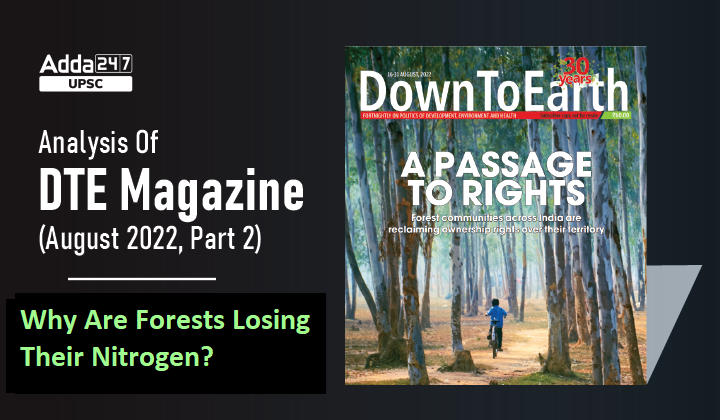Table of Contents
Down To Earth Magazine is a fortnightly magazine focusing on politics of environment and development, published in New Delhi, India.
UPSC Previous years’ questions on Development, Environment, Health and Disaster Management give us a clear idea about the increased importance of Down To Earth Magazine.
Down To Earth Magazine is one of the most important and indispensable sources for UPSC Civil Services Exam Preparation.
Keeping this in mind, here, we come with ”Gist Of Down To Earth Magazine” which covers important environmental current affairs articles in smooth pointed form, keeping in mind the demand of UPSC aspirants.
Why Are Forests Losing Their Nitrogen?: Introduction
- Scientists have known for quite a while that the Nitrogen cycle is getting disrupted.
- The levels of reactive nitrogen have increased tenfold since the pre-industrial era due to rampant use of synthetic nitrogen fertiliser and the burning of fossil fuels, according to a 2019 study published in Frontiers in Ecology and the Environment.
- This has caused algal blooms, created dead zones in oceans and accelerated biological diversity loss in aquatic and terrestrial ecosystems.
- A recent study, however, states that scientists have so far only partly understood the scale of this disruption and where it is unfolding.
- There is both too much nitrogen and too little nitrogen on Earth at the same time as per a study, published in the journal Science in April 2022. Just like too much of nitrogen, declining availability of nitrogen is also a cause of worry.
Why Are Forests Losing Their Nitrogen?: How Plant Absorb Nitrogen?
- Nitrogen is all pervasive. It is more abundant in the air than oxygen and constitutes 78 per cent of the atmosphere.
- Nitrogen is also vital to life — it is essential for plant nutrition and thus, sustains all other beings.
- But plants cannot use atmospheric nitrogen directly the way they absorb carbon dioxide (CO2) for photosynthesis.
- For this, they depend on a biogeochemical cycle that, with the help of some bacteria or even lightning, combines the inert gas with other elements to form reactive compounds like ammonia and nitric oxide and “fix” them in the soil.
Why Are Forests Losing Their Nitrogen?: Twin problem of too much and too little Nitrogen
- While forests with high nitrogen availability suffer from less diversity as they allow certain species to flourish at the cost of others, low-nitrogen forests are more likely to have plants growing slowly with fewer leaves.
- New research found that nitrogen availability is declining in “many non-agricultural terrestrial ecosystems” that do not receive additional reactive nitrogen because of human activities.
- The decline is sustained across a range of terrestrial ecosystems, including forests in the US and Europe as well as grasslands in central and north America, dating at least as far back as the early 20th century.
Why Are Forests Losing Their Nitrogen?: A Looming Crisis
- Human activities are mostly to be blamed for the decline in nitrogen availability and identify multiple environmental changes, particularly elevated atmospheric CO2 and rising global temperatures, as the drivers.
- Atmospheric CO2 concentration has increased by 50 per cent since the 1750s, as per US National Oceanic and Atmospheric Administration.
- This has quickened the rate of photosynthesis in plants up to a saturation point, leading to higher nitrogen demand by plants. Rising temperatures is also known to stretch the growing seasons, adding to this demand.
- Large parts of Australia, sub-Saharan Africa, parts of Asia and South America and vast swathes of boreal forest, that have remained free of additional reactive nitrogen, could lose their natural deposits of nitrogen in a warming world.
Why Are Forests Losing Their Nitrogen?: Why should we link Climate Change with Nitrogen Cycle?
- Data gaps exist because determining nitrogen levels in plants is expensive and time-consuming. This is the reason the link between climate change and the nitrogen cycle remains understudied.
- But understanding the nitrogen cycle in its entirety is crucial as it is a key component of amino acids that form the building blocks of plant proteins and enzymes.
- Reduced levels of nitrogen in plants can have a worrying impact on the health of insects and grazing mammals that depend on leaves for protein.
- Herbivores may initially respond to the situation by increasing consumption, but it eventually affects their growth, survival, reproduction and population size.
- The study by Mason cites a PNAS paper published in 2020, in which researchers have found a link between the decline in nitrogen levels in Konza Prairie, a grassland in Kansas, US, and a 36 per cent drop in grasshopper abundance over the past 30 years.
- With a low protein concentration in pollen, bees might find it harder to resist pests and survive over winter. Grazing mammals on a low-protein diet have poor growth.



 TSPSC Group 1 Question Paper 2024, Downl...
TSPSC Group 1 Question Paper 2024, Downl...
 TSPSC Group 1 Answer key 2024 Out, Downl...
TSPSC Group 1 Answer key 2024 Out, Downl...
 UPSC Prelims 2024 Question Paper, Downlo...
UPSC Prelims 2024 Question Paper, Downlo...
